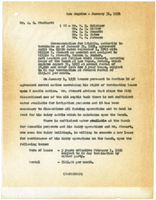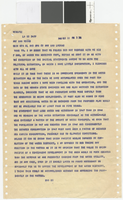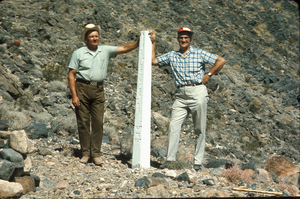Search the Special Collections and Archives Portal
Search Results

Letter from Hugh A. Shamberger (Carson City) to Colonel H. F. Clark (Las Vegas), December 11, 1951
Date
Archival Collection
Description
Shamberger advised the Water District to purchase the lands surrounding the Las Vegas Springs as well as other springs and wells in the area to protect its water sources in the future.
Text

Letter from A. M. Folger (Las Vegas) to Frank Strong, February 21, 1948
Date
Archival Collection
Description
Discussion of drilling two wells on the Las Vegas Ranch to make up for the irrigation water lost by the City forbidding the use of effluent, and of giving up acreage for the Elks and a sewer treatment plant.
Text

Letter from A. M. Folger (Las Vegas) to William Reinhardt, November 17, 1950
Date
Archival Collection
Description
Lessees of the Las Vegas Ranch quit paying their rent when the water to the ranch quit flowing. Upon being reminded of the terms of the lease, they paid the rent, but asked for future water delivery plans.
Text

Letter from William Reinhardt (Los Angeles) to A. E. Stoddard, January 31, 1951
Date
Archival Collection
Description
Willie T. Stewart was terminating the lease due to insufficient water on the ranch. He was willing to sign a new lease given the listed terms. Letter refers to outlined areas noted on map referenced below.
Text

Letter from Howard W. Cannon (Las Vegas) to W. H. Johnson (Las Vegas), April 17, 1951
Date
Archival Collection
Description
The irrigation practices on the Las Vegas Ranch were being blamed for the mosquito problem in Las Vegas, and the Las Vegas Land and Water Company was being asked to address it.
Text

Letter from William Reinhardt to G.F. Ashby, October 11, 1948
Date
Archival Collection
Description
Reinhardt recommends that the water company remain non-committal about the creation of a water district in Las Vegas until it is clear how it would affect the interests of the Union Pacific Railroad Company.
Text

Slide of John Lytle at Emigrant (Fremont) Gap on the Old Spanish Trail, California, circa 1960s
Date
Archival Collection
Description
Image
Perry Kaufman Papers
Identifier
Abstract
The Perry Kaufman Papers (1930-1974) are comprised of research material gathered by Kaufman for his doctoral dissertation, "The Best City of Them All: A History of Las Vegas, 1930-1960." Kaufman's research focused on the Las Vegas, Nevada Chamber of Commerce's role in promoting Las Vegas as a tourist destination. The collection primarily consists of newspaper clippings from the
Archival Collection
Robert E. Robinson Legislative Papers
Identifier
Abstract
The Robert E. Robinson Legislative Papers are comprised of materials relating to Robert Robinson’s career in the Nevada State Legislature as an assemblyman and senator from 1970 to 1986. The papers include correspondence, assembly bill research, bill proposals, roll calls, and materials from assembly committee meetings. The collection also contains Robinson’s campaign materials, including financial disclosures, press releases, advertisements, and correspondence with voters.
Archival Collection

